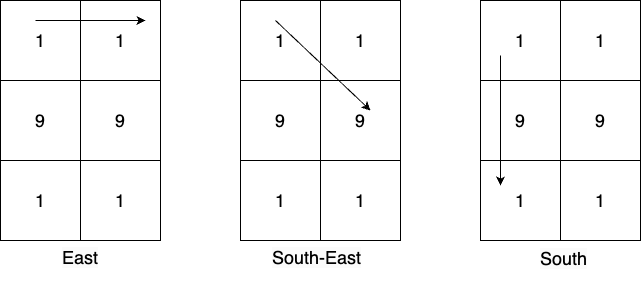出现频率最高的质数
难度:
标签:
题目描述
You are given a m x n 0-indexed 2D matrix mat. From every cell, you can create numbers in the following way:
- There could be at most
8paths from the cells namely: east, south-east, south, south-west, west, north-west, north, and north-east. - Select a path from them and append digits in this path to the number being formed by traveling in this direction.
- Note that numbers are generated at every step, for example, if the digits along the path are
1, 9, 1, then there will be three numbers generated along the way:1, 19, 191.
Return the most frequent prime number greater than 10 out of all the numbers created by traversing the matrix or -1 if no such prime number exists. If there are multiple prime numbers with the highest frequency, then return the largest among them.
Note: It is invalid to change the direction during the move.
Example 1:

Input: mat = [[1,1],[9,9],[1,1]] Output: 19 Explanation: From cell (0,0) there are 3 possible directions and the numbers greater than 10 which can be created in those directions are: East: [11], South-East: [19], South: [19,191]. Numbers greater than 10 created from the cell (0,1) in all possible directions are: [19,191,19,11]. Numbers greater than 10 created from the cell (1,0) in all possible directions are: [99,91,91,91,91]. Numbers greater than 10 created from the cell (1,1) in all possible directions are: [91,91,99,91,91]. Numbers greater than 10 created from the cell (2,0) in all possible directions are: [11,19,191,19]. Numbers greater than 10 created from the cell (2,1) in all possible directions are: [11,19,19,191]. The most frequent prime number among all the created numbers is 19.
Example 2:
Input: mat = [[7]] Output: -1 Explanation: The only number which can be formed is 7. It is a prime number however it is not greater than 10, so return -1.
Example 3:
Input: mat = [[9,7,8],[4,6,5],[2,8,6]] Output: 97 Explanation: Numbers greater than 10 created from the cell (0,0) in all possible directions are: [97,978,96,966,94,942]. Numbers greater than 10 created from the cell (0,1) in all possible directions are: [78,75,76,768,74,79]. Numbers greater than 10 created from the cell (0,2) in all possible directions are: [85,856,86,862,87,879]. Numbers greater than 10 created from the cell (1,0) in all possible directions are: [46,465,48,42,49,47]. Numbers greater than 10 created from the cell (1,1) in all possible directions are: [65,66,68,62,64,69,67,68]. Numbers greater than 10 created from the cell (1,2) in all possible directions are: [56,58,56,564,57,58]. Numbers greater than 10 created from the cell (2,0) in all possible directions are: [28,286,24,249,26,268]. Numbers greater than 10 created from the cell (2,1) in all possible directions are: [86,82,84,86,867,85]. Numbers greater than 10 created from the cell (2,2) in all possible directions are: [68,682,66,669,65,658]. The most frequent prime number among all the created numbers is 97.
Constraints:
m == mat.lengthn == mat[i].length1 <= m, n <= 61 <= mat[i][j] <= 9
代码结果
运行时间: 87 ms, 内存: 16.0 MB
/*
题目思路:
1. 定义一个方法用于判断一个数是否是质数。
2. 使用流式操作生成每个单元格的所有可能的路径数字。
3. 使用流操作统计所有大于 10 的质数的频率,找到出现频率最高的质数。
*/
import java.util.*;
import java.util.stream.*;
public class Solution {
private boolean isPrime(int num) {
if (num <= 1) return false;
for (int i = 2; i * i <= num; i++) {
if (num % i == 0) return false;
}
return true;
}
public int mostFrequentPrime(int[][] mat) {
int m = mat.length, n = mat[0].length;
int[][] directions = {{0, 1}, {1, 1}, {1, 0}, {1, -1}, {0, -1}, {-1, -1}, {-1, 0}, {-1, 1}};
Map<Integer, Long> primeCountMap = IntStream.range(0, m)
.boxed()
.flatMap(i -> IntStream.range(0, n)
.boxed()
.flatMap(j -> Arrays.stream(directions)
.map(dir -> {
List<Integer> numbers = new ArrayList<>();
int x = i, y = j, num = 0;
while (x >= 0 && x < m && y >= 0 && y < n) {
num = num * 10 + mat[x][y];
numbers.add(num);
x += dir[0];
y += dir[1];
}
return numbers.stream();
})
.flatMap(s -> s)
.filter(n -> n > 10 && isPrime(n))))
.collect(Collectors.groupingBy(n -> n, Collectors.counting()));
return primeCountMap.entrySet().stream()
.max(Map.Entry.<Integer, Long>comparingByValue()
.thenComparing(Map.Entry.comparingByKey()))
.map(Map.Entry::getKey)
.orElse(-1);
}
}解释
方法:
这个题解首先定义了所有可能的移动方向,即8个方向(东、东南、南等)。然后,使用一个辅助函数chkPrime来检查一个数字是否是大于10的质数。对于矩阵中的每个元素,它尝试所有8个方向,并沿着每个方向生成新的数字,使用累加的方式将当前数字附加在已有数字之后。如果生成的数字是一个质数,则在字典d中记录该数字的出现次数。最后,将字典中的项目按出现次数降序排序,如果有相同频次的质数,则按数值降序排序,返回出现频率最高的质数。如果没有找到任何符合条件的质数,则返回-1。
时间复杂度:
O(m*n*(m+n)*sqrt(a))
空间复杂度:
O(m*n*(m+n))